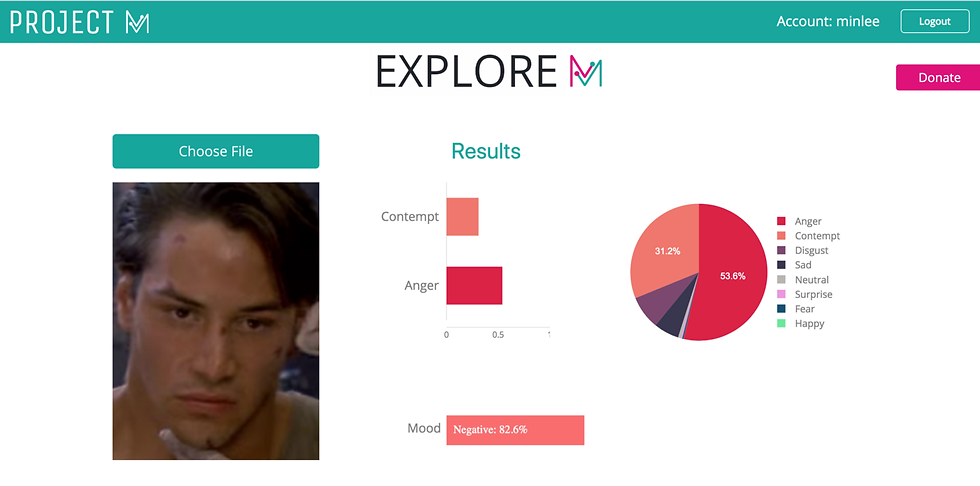M vs Microsoft Episode 27
- Rimma Ten
- Feb 6, 2021
- 3 min read
Can AI Detect Subtle Negative Emotions?


What's happening in this image?
This is Johnny Utah, a rookie FBI agent, who was hired to assist an experienced agent Angelo Pappas in investigating a string of bank robberies that were carried out by a dangerous gang of criminals.
No FBI agents were able to catch these criminals, but Utah (a man in the picture) was determined that they can catch them. So following his boss’s theory (Angelo Pappas) that the criminals were surfers, Utah went undercover to befriend the gang leader and retrieve more information on their next move on robbing another bank.
Utah fell in love with a female surfer who was close to the gang and through her, he got accepted into the gang, and he even befriended its leader. Later on, the gang found out that Utah was an undercover FBI agent, and decided to use him in their next move on the bank robbery. By doing so, they kidnapped Utah’s girlfriend so that he could help them in their evil plan.
The picture depicts the moment when Utah was pretty upset by the fact that he was used by the gang of criminals who got what they wanted and successfully fled the crime scene.
Now let’s see what M and Microsoft Azure identify:

M identifies his emotional state as Angry at 53% as the primary emotion, Contempt at 31% as the secondary emotion, and Disgust at 8% in the pie chart. It also identifies his mood as Negative at 82%.
When we are feeling anger because we were being used as Utah was by the criminals or being treated unfairly, facing injustice or you are not being appreciated, your body’s muscles tense up, and you can clearly see the tension on Utah’s face and some parts of his neck. The expression of anger on his face is passive meaning that he’s experiencing anger in silence which can be characterized as silent sulking, passive-aggressiveness behavior (hostility), and tension (Addotta, 2006, para. 10).
Anger is a powerful emotion that can be negative and positive. In Utah’s case, it is positive, because anger can motivate positive actions and outcomes — to catch the criminals and bring them to justice, which links to the secondary emotion Contempt as M correctly identifies here. Utah feels disgusted because the criminals used him in their evil plan and that he couldn’t do anything to stop them, which is why M sees Disgust in its screening readings.
Now, let’s test Microsoft Azure using the same image:

Microsoft Azure’s emotional readings show that Utah is experiencing Neutral at 0.99% as the primary emotion, which means that he doesn’t feel any emotions at this right moment, which is incorrect as we discussed earlier in the article. Why does Azure identify the young man’s emotional state as Neutral?
The answer is simple — the man doesn’t exhibit much facial muscle movement for the computer vision to read the emotions correctly. Since there aren’t any facial muscle movement, Azure incorrectly identifies it as Neutral.
Now that you know the context behind the situation and the two different emotional readings, it is up to you to decide what interpretation you think is most accurate.
We, at Project M, believe the ability of emotional artificial intelligence platform to identify and understand subtle negative emotions has great potential to optimize humans’ emotional well being.
Follow us on our social media and look out for our next episode!
Your LIKE means a lot to us! Follow Project M on:
Project M: https://projectm.ipmdinc.com
IPMD website: http://www.ipmdinc.com
Medium: Project M
Facebook: Project M
Blogger: Project M
Instagram: mprojectai
Twitter: @mprojectai
LinkedIn: Project M
*As of February 1, 2021, the Project M team has devoted 102,000 hours to the AI platform, M. The sample input data we are using is the pure testing data that is completely new to M and Microsoft (assumed) and has never been used to train M, so this comparison is a fair trial between M and Microsoft. We appreciate Microsoft, the leader of the industry and emotional AI sector, for allowing the general public to test their testing site for identifying human emotions based on facial expressions.



Comments